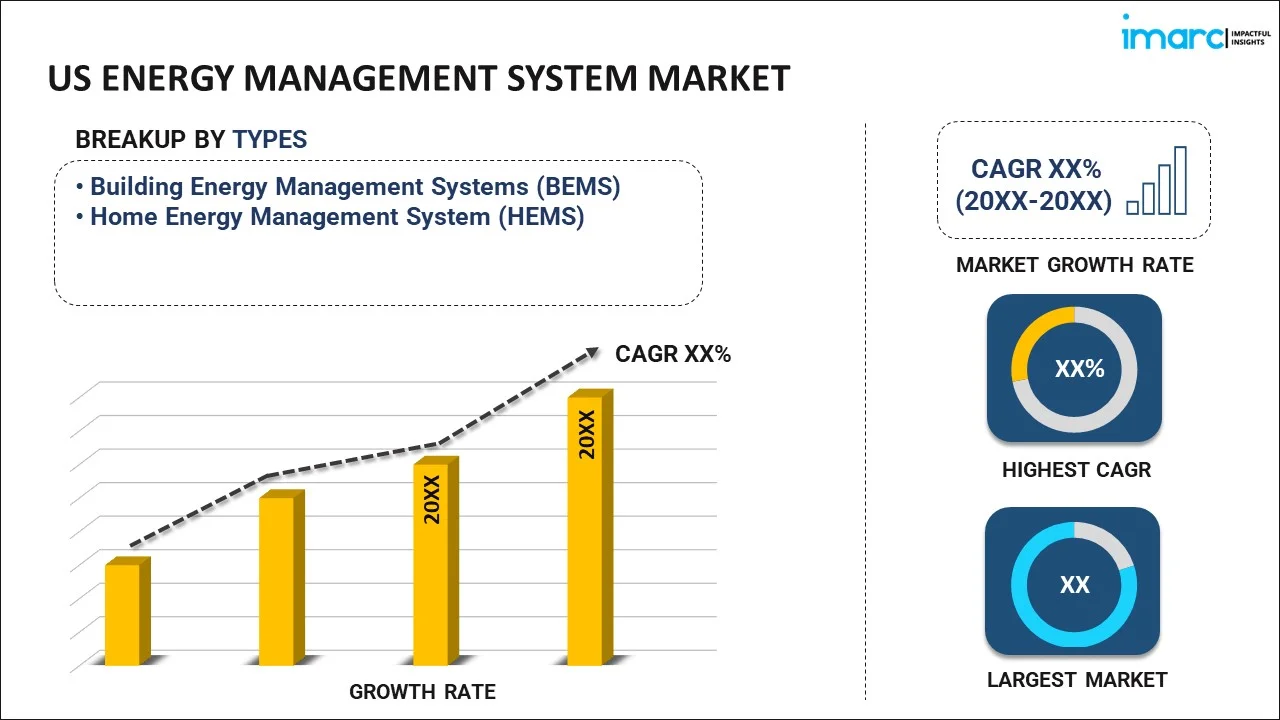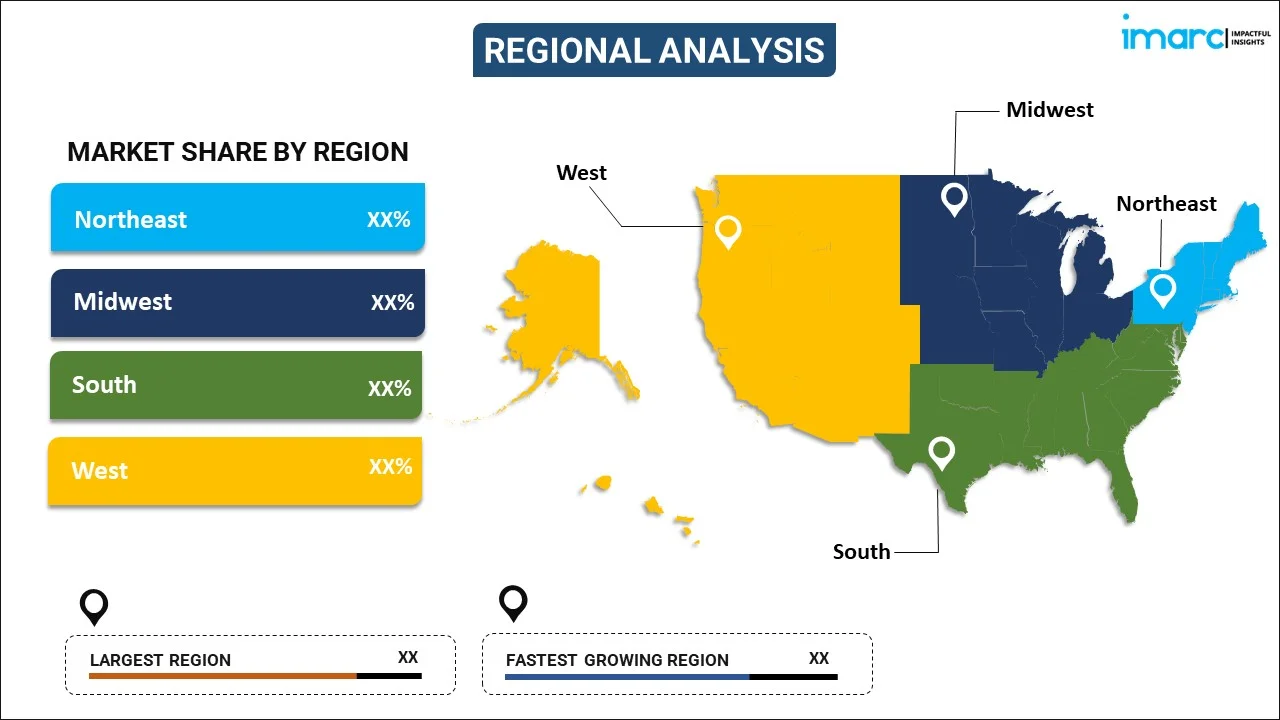
US Energy Management System Market Report by Type (Building Energy Management Systems (BEMS), Home Energy Management System (HEMS)), Software (Utility Energy Management, Industrial Energy Management, Enterprise Carbon and Energy Management, Residential Energy Management), Deployment (Cloud-based, On-premised), End User (Automotive, Oil and Gas, Manufacturing, Healthcare, Power and Energy, and Others), and Region 2025-2033
Market Overview:
The US energy management system market size reached USD 18.2 Billion in 2024. Looking forward, IMARC Group expects the market to reach USD 37.9 Billion by 2033, exhibiting a growth rate (CAGR) of 8.2% during 2025-2033. The increasing energy costs, rising governments regulations and sustainability goals, the rapid advancements in the Internet of Things (IoT) and data analytics, and the operational efficiency offered by the product represent some of the key factors driving the market.
|
Report Attribute
|
Key Statistics
|
|---|---|
|
Base Year
|
2024 |
|
Forecast Years
|
2025-2033
|
|
Historical Years
|
2019-2024
|
| Market Size in 2024 | USD 18.2 Billion |
| Market Forecast in 2033 | USD 37.9 Billion |
| Market Growth Rate (2025-2033) | 8.2% |
An energy management system (EMS) is a comprehensive framework designed to monitor, control, and optimize energy consumption in various settings, from industrial facilities and commercial buildings to residential homes. Integrating advanced technologies like IoT sensors, data analytics, and automation enables efficient energy usage, cost reduction, and environmental sustainability. EMSs offer real-time insights into energy consumption patterns, allowing users to identify inefficiencies, peak usage periods, and potential areas for improvement. These systems often employ predictive analytics to forecast energy demand, helping organizations plan for optimal energy distribution and prevent costly overloads. EMS users can remotely monitor and control energy-consuming devices and systems through centralized dashboards and remote access capabilities. This enables timely adjustments, load balancing, and even automated responses to fluctuations in energy demand, reducing waste and improving overall energy efficiency. In addition to economic benefits, EMSs play a pivotal role in achieving environmental goals. Organizations can minimize their carbon footprint and contribute to sustainability targets by curbing excessive energy usage. As technologies evolve and energy management becomes increasingly vital, EMSs are poised to become integral tools for businesses, industries, and individuals striving for financial savings and a greener future.
US Energy Management System Market Trends:
The market in the U.S. is experiencing robust growth due to a confluence of factors. The escalating energy costs have compelled businesses and industries to seek effective means of curbing expenses. EMS solutions offer real-time monitoring, analysis, and control of energy consumption, enabling companies to identify wastage and implement strategies for optimization. Furthermore, the U.S. government's commitment to sustainability and energy efficiency has led to stringent regulations and incentives. Organizations are compelled to adhere to these mandates, spurring the adoption of EMS to achieve compliance and align with environmental targets. Besides, technological advancements, particularly the Internet of Things (IoT) and data analytics, have revolutionized energy management. The integration of smart meters, sensors, and connected devices allows for detailed energy monitoring and informed decision-making, amplifying the appeal of EMS solutions. Apart from this, the manufacturing industry is increasingly focusing on reducing operational costs and environmental impact, thereby contributing to the EMS market growth. The integration of renewable energy adds complexity to energy management, further necessitating the adoption of EMS solutions. Additionally, the emphasis on corporate social responsibility and the growing awareness of environmental impact drive companies to embrace energy-efficient practices. EMS offers operational savings and supports eco-friendly initiatives, resonating with consumers and stakeholders alike. With these factors interplaying, the EMS market in the United States is poised for sustained expansion.
US Energy Management System Market Segmentation:
IMARC Group provides an analysis of the key trends in each segment of the US energy management system market report, along with forecasts at the country level for 2025-2033. Our report has categorized the market based on type, software, deployment, and end user.
Type Insights:

- Building Energy Management Systems (BEMS)
- Home Energy Management System (HEMS)
The report has provided a detailed breakup and analysis of the market based on the type. This includes building energy management systems (BEMS) and home energy management system (HEMS).
Software Insights:
- Utility Energy Management
- Industrial Energy Management
- Enterprise Carbon and Energy Management
- Residential Energy Management
The report has provided a detailed breakup and analysis of the market based on the software. This includes utility energy management, industrial energy management, enterprise carbon and energy management, and residential energy management.
Deployment Insights:
- Cloud-based
- On-premised
The report has provided a detailed breakup and analysis of the market based on the deployment. This includes cloud-based and on-premised.
End User Insights:
- Automotive
- Oil and Gas
- Manufacturing
- Healthcare
- Power and Energy
- Others
The report has provided a detailed breakup and analysis of the market based on the end user. This includes automotive, oil and gas, manufacturing, healthcare, power and energy, and others.
Regional Insights:

- Northeast
- Midwest
- South
- West
The report has also provided a comprehensive analysis of all the major regional markets, which include northeast, Midwest, south, and west.
Competitive Landscape:
The report has also provided a comprehensive analysis of the competitive landscape in the market. Competitive analysis such as market structure, key player positioning, top winning strategies, competitive dashboard, and company evaluation quadrant has been covered in the report. Also, detailed profiles of all major companies have been provided.
US Energy Management System Market Report Coverage:
| Report Features | Details |
|---|---|
| Base Year of the Analysis | 2024 |
| Historical Period | 2019-2024 |
| Forecast Period | 2025-2033 |
| Units | Billion USD |
| Scope of the Report | Exploration of Historical and Forecast Trends, Industry Catalysts and Challenges, Segment-Wise Historical and Predictive Market Assessment:
|
| Types Covered | Building Energy Management Systems (BEMS), Home Energy Management System (HEMS) |
| Softwares Covered | Utility Energy Management, Industrial Energy Management, Enterprise Carbon and Energy Management, Residential Energy Management |
| Deployments Covered | Cloud-based, On-premised |
| End Users Covered | Automotive, Oil and Gas, Manufacturing, Healthcare, Power and Energy, Others |
| Regions Covered | Northeast, Midwest, South, West |
| Customization Scope | 10% Free Customization |
| Post-Sale Analyst Support | 10-12 Weeks |
| Delivery Format | PDF and Excel through Email (We can also provide the editable version of the report in PPT/Word format on special request) |
Key Questions Answered in This Report:
- How has the US energy management system market performed so far, and how will it perform in the coming years?
- What has been the impact of COVID-19 on the US energy management system market?
- What is the breakup of the US energy management system market on the basis of type?
- What is the breakup of the US energy management system market on the basis of software?
- What is the breakup of the US energy management system market on the basis of deployment?
- What is the breakup of the US energy management system market on the basis of end user?
- What are the various stages in the value chain of the US energy management system market?
- What are the key driving factors and challenges in the US energy management system market?
- What is the structure of the US energy management system market, and who are the key players?
- What is the degree of competition in the US energy management system market?
Key Benefits for Stakeholders:
- IMARC’s report offers a comprehensive quantitative analysis of various market segments, historical and current market trends, market forecasts, and dynamics of the US energy management system market from 2019-2033.
- The research study provides the latest information on the market drivers, challenges, and opportunities in the US energy management system market.
- The study maps the leading, as well as the fastest-growing, regional markets. It further enables stakeholders to identify the key country-level markets within each region.
- Porter's five forces analysis assists stakeholders in assessing the impact of new entrants, competitive rivalry, supplier power, buyer power, and the threat of substitution. It helps stakeholders to analyze the level of competition within the US energy management system industry and its attractiveness.
- Competitive landscape allows stakeholders to understand their competitive environment and provides an insight into the current positions of key players in the market.
Need more help?
- Speak to our experienced analysts for insights on the current market scenarios.
- Include additional segments and countries to customize the report as per your requirement.
- Gain an unparalleled competitive advantage in your domain by understanding how to utilize the report and positively impacting your operations and revenue.
- For further assistance, please connect with our analysts.
 Request Customization
Request Customization
 Speak to an Analyst
Speak to an Analyst
 Request Brochure
Request Brochure
 Inquire Before Buying
Inquire Before Buying




.webp)




.webp)












